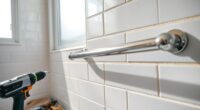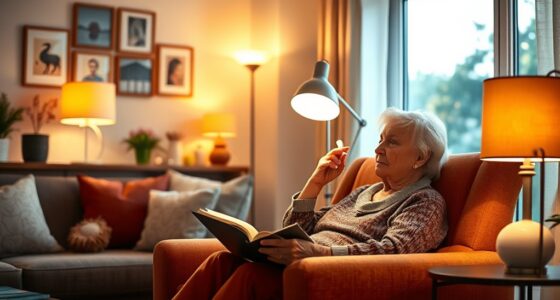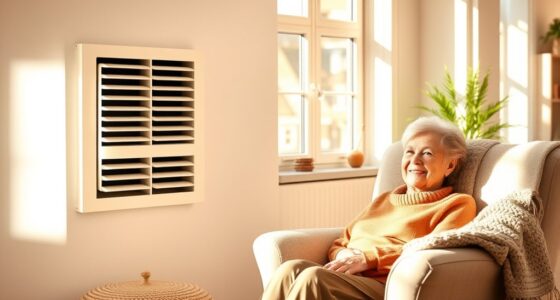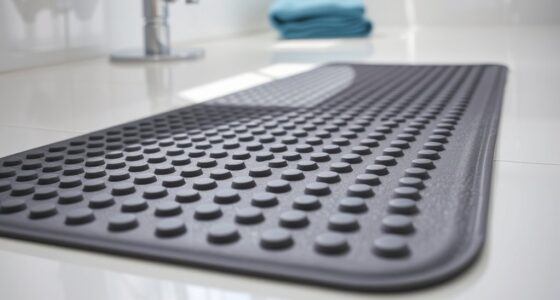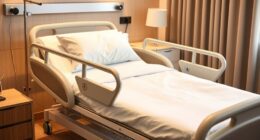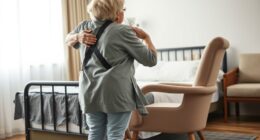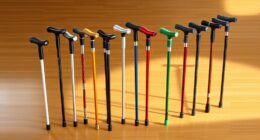To guarantee senior safety and comfort, focus on essential home modifications like installing grab bars, improving lighting, and using non-slip flooring. Widen doorways for mobility aids, convert to single-floor living, and add ramps for easier access. In the kitchen, lower countertops and use pull-out shelves for convenience. Incorporating smart home technology can enhance safety, while emergency preparedness features like voice activation can provide peace of mind. Find out how these changes can transform living spaces for seniors.
Key Takeaways
- Install grab bars and handrails in bathrooms and stairways to significantly reduce fall risks for seniors.
- Improve lighting with brighter bulbs and motion-sensor lights for enhanced visibility in living spaces.
- Use non-slip flooring materials and secure rugs with non-slip backing to minimize tripping hazards.
- Modify bathrooms with walk-in showers, non-slip mats, and raised toilet seats for added safety and accessibility.
- Widen doorways to at least 32 inches to facilitate easier movement for seniors using mobility aids.
Understanding Home Modifications for Seniors

As you age, understanding home modifications becomes essential for maintaining safety and independence. Home modifications for seniors address unique challenges like reduced mobility and increased fall risk. By creating a safer and more accessible environment, you can navigate your home with ease and perform daily tasks with minimal assistance.
Common modifications focus on high-risk areas, such as bathrooms and kitchens, where falls are more likely to occur. Installing grab bars, improving lighting, and adjusting shelving heights can greatly reduce hazards. Additionally, incorporating regular physical activity into your routine can enhance overall strength and balance, further reducing the risk of falls.
Engaging professionals, like occupational therapists, helps identify specific risks and recommend tailored modifications. Ultimately, these changes enhance your overall well-being, allowing you to live comfortably and confidently in your own space.
Examples of Home Modifications for Seniors

When it comes to making your home safer and more accessible, several modifications can make a big difference.
Consider adding essential features like grab bars and non-slip flooring, which help prevent falls.
You can also enhance accessibility with ramps and lever-style door handles, making it easier to move around your space. Additionally, incorporating best home security systems can provide peace of mind and ensure a safer living environment for seniors.
Essential Safety Features
Creating a safe home environment for seniors involves several essential modifications that can greatly reduce the risk of accidents.
Installing grab bars and handrails in bathrooms and along stairways provides vital support, helping seniors maintain balance during daily activities.
Additionally, enhancing lighting throughout your home with brighter bulbs and motion-sensor lights improves visibility, particularly in dimly lit areas, preventing unexpected falls.
It's also wise to invest in non-slip flooring materials, like textured vinyl or rubber, especially in moisture-prone areas such as kitchens and bathrooms, to minimize slip hazards. Implementing these modifications can contribute to financial stability post-divorce, allowing seniors to feel secure in their living environment.
Accessibility Enhancements
To enhance accessibility in a senior’s home, consider implementing a variety of modifications that cater to their specific needs. These changes can include installing grab bars in key areas such as the bathroom, ensuring that floors are free of tripping hazards, and using adjustable furniture for comfort. Additionally, improving lighting throughout the home can greatly assist in navigation and reduce the risk of falls. For a comprehensive approach, refer to universal design tips for seniors, which provide practical solutions to create a safe and comfortable living environment tailored to their unique requirements.
Start by installing grab bars in bathrooms to provide support, greatly reducing fall risks when moving in and out of showers or near toilets.
Widening doorways to at least 32 inches allows easier movement for wheelchairs and walkers.
Convert to single-floor living spaces to minimize stair navigation and enhance safety.
Additionally, implementing non-slip flooring in high-traffic areas, like kitchens and bathrooms, decreases the likelihood of slips.
Finally, adding ramps at entryways replaces stairs, ensuring safe access for individuals with mobility challenges.
Incorporating eco-friendly practices in home modifications can further promote a healthier living environment for seniors.
These accessibility enhancements create a more comfortable and secure environment for seniors.
Types of Home Modifications for Seniors

When it comes to making your home safer and more accessible, several key modifications can make a big difference.
You can enhance bathroom safety with grab bars and non-slip flooring, improve kitchen accessibility with lower countertops, and add mobility support features like stairlifts.
These changes not only promote safety but also help you maintain your independence and comfort at home.
Bathroom Safety Enhancements
Ensuring bathroom safety is essential for seniors looking to maintain their independence and prevent accidents at home. Implementing specific modifications can considerably enhance safety and comfort. Additionally, integrating pet therapy into their routine can further promote emotional well-being and companionship.
| Modification | Benefits |
|---|---|
| Grab Bars | Provide essential support, reducing fall risk |
| Non-Slip Mats | Prevent slips in wet areas |
| Walk-In Showers | Minimize accidents with no high thresholds |
| Shower Chair | Offers stability and comfort while bathing |
| Raised Toilet Seat | Eases sitting and standing, reducing strain |
Kitchen Accessibility Improvements
Making your kitchen more accessible can greatly enhance your daily cooking experience and boost safety. Start by lowering countertops to a comfortable height, so you can prepare meals without straining.
Consider kitchen accessibility improvements like installing pull-out shelves and drawers, which keep frequently used items within reach and reduce bending.
Lever-style faucets are a must; they're easier to operate, especially if you have limited hand strength or arthritis.
Adding non-slip mats in areas prone to spills can prevent slips and falls, ensuring a safer environment.
Finally, keep pathways clear of clutter to facilitate easy navigation, especially if you use a walker or wheelchair. Additionally, consider using non-slip mats to enhance safety further in areas that may accumulate moisture or spills.
These simple modifications can considerably improve your kitchen experience.
Mobility Support Features
After enhancing kitchen accessibility, it's important to contemplate other mobility support features that can further improve safety and independence at home.
Installing grab bars in bathrooms and near stairways can provide essential support, greatly reducing fall risks during daily activities.
If stairs pose a challenge, consider replacing them with ramps for easier access, especially for those using wheelchairs or walkers.
Widening doorways to at least 36 inches also helps accommodate mobility aids, ensuring smoother navigation throughout your space.
Additionally, switching to lever-style door handles makes it easier for seniors with limited hand strength to operate doors.
Finally, installing stairlifts on staircases offers a safe way to navigate between floors, improving overall mobility for seniors with challenges. Furthermore, maintaining optimal performance of home air quality systems can also contribute to a healthier and safer living environment for seniors.
Benefits of Home Modifications for Seniors

Home modifications can transform a senior's living space into a safer and more accessible environment, considerably reducing the risk of falls—one of the leading causes of injury among older adults.
By addressing hazardous areas like bathrooms and stairways, you enhance safety and promote independence. Features such as grab bars, ramps, and lever-style door handles make daily tasks easier, allowing seniors to enjoy accessible living with minimal assistance.
Improved lighting and non-slip flooring also create a safer atmosphere, cutting down accidents from poor visibility.
Plus, home modifications can boost mental well-being, fostering confidence and reducing anxiety for both seniors and caregivers. Incorporating smart home technology adds convenience and security, ensuring quick access to help during emergencies. Additionally, integrating Alzheimer bracelets can provide critical identification in emergencies, further enhancing safety for seniors with cognitive impairments.
How to Implement Home Modifications for Seniors

To effectively implement home modifications for seniors, start by conducting a thorough assessment of the living space. Focus on high-risk areas like bathrooms and kitchens, where safety is vital. Consult professionals, such as occupational therapists or certified Aging-in-Place Specialists, for tailored recommendations. Additionally, consider incorporating mindfulness practices to enhance self-awareness and ensure modifications align with the needs of the seniors.
Next, create a budget and timeline, considering financial assistance options like grants and loans to alleviate costs. Regularly evaluate the modifications to guarantee they meet the evolving needs of seniors.
| Area to Modify | Recommended Modification | Potential Benefit |
|---|---|---|
| Bathroom | Grab bars | Reduces fall risk |
| Kitchen | Adjustable counters | Enhances accessibility |
| Living Room | Clear pathways | Increases mobility |
| Bedroom | Bed rails | Improves safety |
| Entryway | Ramps | Facilitates access |
Costs of Home Modifications for Seniors

When considering the costs of home modifications for seniors, it's essential to understand that expenses can vary widely based on the type of changes needed.
Simple changes, like replacing doorknobs with lever handles, can cost as little as $20 to $100 per door, while installing grab bars typically ranges from $100 to $300.
More significant modifications, such as adding ramps, can range from $1,000 to $3,000.
If you need to widen doorways for wheelchair access, expect costs between $500 and $2,500.
Major renovations, like stairlifts, can set you back $3,000 to $15,000.
Fortunately, financial assistance options, including grants and loans, can help cover the costs of home modifications, easing the financial burden.
Essential Modifications for Safety

Guaranteeing safety at home is essential for seniors, especially as mobility and balance may decline with age. Implementing important home modifications can greatly reduce the risk of falls.
Start by installing grab bars in bathrooms for reliable support when using toilets and showers. Improve lighting with brighter bulbs and motion-sensor fixtures to enhance visibility in key areas like hallways and stairways.
Secure rugs and carpets with non-slip backing to minimize tripping hazards. Consider modifying bathrooms with non-slip mats, walk-in showers, and raised toilet seats for added safety.
Finally, rearranging furniture to create wide, unobstructed pathways guarantees you can navigate your home safely. Additionally, ensuring that air quality is optimal with regular maintenance of air purifiers promotes a healthier living environment. These modifications are critical for promoting seniors' safety and comfort in their living environment.
Enhancing Accessibility in the Home
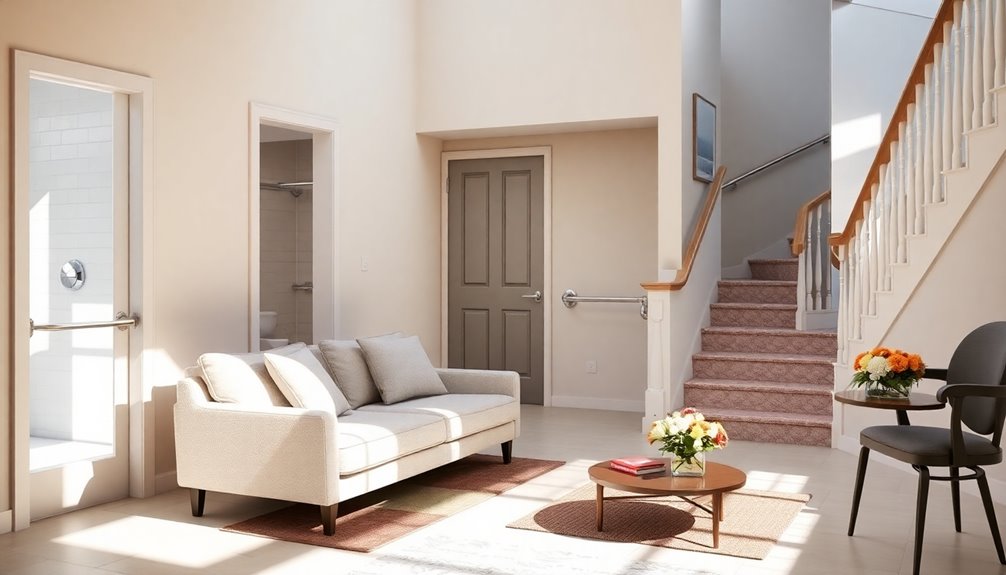
As you consider enhancing accessibility in your home, implementing thoughtful modifications can greatly improve daily living for seniors.
Here are some effective home modifications to guarantee safety and comfort:
- Install grab bars and handrails in bathrooms and stairways to prevent falls.
- Widen doorways to at least 36 inches for easier movement with wheelchairs or mobility aids.
- Use lever-style door handles instead of knobs to reduce strain for those with arthritis.
- Add ramps at entryways to eliminate barriers for seniors using walkers or wheelchairs.
These adjustments can considerably enhance accessibility, allowing seniors to navigate their homes safely and independently while promoting a more comfortable living environment.
Smart Home Technology for Seniors

Smart home technology can make your life much easier and safer.
With voice-activated assistance, you can control lights and security systems without lifting a finger.
These innovations not only enhance convenience but also provide peace of mind for you and your loved ones.
Voice-Activated Assistance
How can voice-activated assistance transform daily life for seniors? By integrating smart home devices, you can markedly enhance comfort and safety while reducing physical exertion.
Here are some key benefits:
- Control Your Environment: Use voice commands to adjust lights, locks, and thermostats effortlessly.
- Emergency Support: Quickly call for help through integrated medical alert technologies without reaching for a phone.
- Health Management: Set customizable reminders for medications and appointments, promoting independence and well-being.
- Mental Health Boost: Enjoy reduced loneliness and a sense of control over your surroundings.
With accuracy rates exceeding 95%, voice-activated assistance is user-friendly, making daily tasks simpler and more manageable for seniors.
Home Security Systems
Home security systems are essential for enhancing safety and peace of mind for seniors living independently. These systems often come equipped with emergency buttons and motion sensors, ensuring quick assistance during falls or emergencies.
With smart home technology, you can receive real-time alerts and access live video feeds, allowing you and your family to monitor your living environment remotely. Many systems integrate with voice-activated assistants, making it easy to control locks, lights, and alarms hands-free—especially important if you face mobility challenges.
Smart door locks eliminate the need for traditional keys, enhancing accessibility and reducing lockout risks. Utilizing these devices greatly boosts peace of mind for both you and your caregivers, alerting you to any unusual activity or security breaches instantly.
Long-term Value of Home Modifications

While investing in home modifications may seem intimidating at first, the long-term value they provide can far exceed the initial costs.
These changes not only enhance safety but also greatly improve quality of life. Consider the following benefits:
- Increased Independence: Seniors can perform daily activities with less assistance.
- Reduced Risk of Falls: Safety features like grab bars can reduce the risk of falls by up to 50%.
- Lower Healthcare Costs: Modified homes lead to fewer hospitalizations and reduced medical expenses.
- Improved Mental Health: A safe environment fosters social engagement and reduces anxiety and depression.
With various financing options available, investing in home modifications makes sense for enhancing comfort and safety in your home.
Frequently Asked Questions
What Are Home Modifications as a Way for an Older Person to Age in Place?
Home modifications are changes you can make to your living space to enhance safety and comfort as you age in place.
These adaptations help you navigate your home more easily and reduce the risk of falls.
Simple updates like installing grab bars, ensuring good lighting, and choosing non-slip flooring can make a big difference.
What Are Examples of Home Modifications?
You might think your home is perfectly fine, but a few tweaks can make a world of difference.
For example, installing grab bars in the bathroom helps you stay steady, while widening doorways to at least 36 inches guarantees you can navigate easily, even with a walker.
Don't forget ramps at entryways to replace those pesky stairs, and non-slip flooring to keep you safe from slips.
Bright lights also make a huge difference in visibility!
What Is Home Safety for Older Adults?
Home safety for older adults means creating a space that reduces fall risks and enhances accessibility.
You'll want to focus on making your environment secure and comfortable. Simple changes, like adding grab bars, improving lighting, and ensuring non-slip flooring, can greatly lower the chances of accidents.
Regularly evaluating your home helps you spot potential hazards, allowing you to make timely adjustments that cater to your evolving needs and promote independence.
Conclusion
Incorporating these home modifications not only boosts safety and comfort but also transforms your living space into a sanctuary tailored for your needs. Imagine gliding through your home with ease, free from the worry of hazards. Isn't it comforting to know that small changes can lead to a safer, more accessible environment? By investing in these upgrades, you're not just enhancing your quality of life today, but also securing a brighter, more independent future.

